In the post-covid battle for talent, occupiers are demanding super-green spaces in which to work with a clear sense of place. Daniel Gayne looks at Manchester’s best efforts to satisfy them
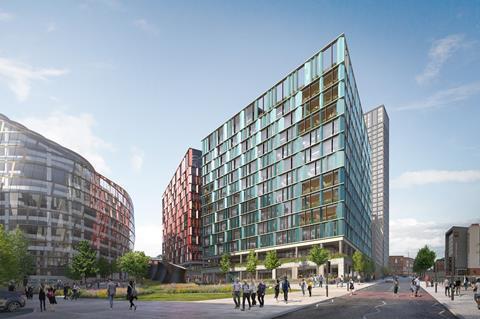

In 2019, the last time that Building took an in-depth look at Manchester’s real estate market, analysts speculated that the city’s long residential boom could be cooling and that the commercial office could be the next growth market. A lot, you may have noticed, has changed since 2019.
Through three years of lingering pandemic and on-off lockdowns, that slowdown in residential construction never materialised, maintained by strong private rental demand. In the office market, by contrast, it has been a bewildering few years as employees, occupiers, landlords and developers adapted to the brave new world of home and hybrid working.
Stubbornly low occupancy rates make it clear that we have entered a new paradigm in how offices are used, although the exact levels of homeworking in the UK remain unclear – a PwC survey taken this spring claimed that 66% of UK employees worked either fully or mostly remotely, while an ONS report, published around the same time, recorded a much lower 38% as having worked from home at some point during the previous seven days.
Amid the uncertainty, levels of new office building in Manchester have wavered. According to Deloitte’s crane survey, a relatively small 400,000ft2 was delivered to the market last year – 66% down from the 1.2 million ft2 completed in 2020 – although levels are expected to rebound somewhat, with 740,000ft2 due to complete this year and 580,00ft2 in 2023.
But while the picture remains hazy at the aggregate level, Richard Wharton, director of JLL’s Manchester office, says individual firms are beginning to understand their own needs and are getting ready to move in the market. “Having now had six or nine months since covid, you’ve got a bit of a pattern as to what staff want to do, what the business or corporate line is,” he says. “So we can say, ‘[…] we are in 20,000[ft2] and actually we think we can get away with 14,000[ft2]’, so hence we can make a decision, we can go to market and we know what we want.
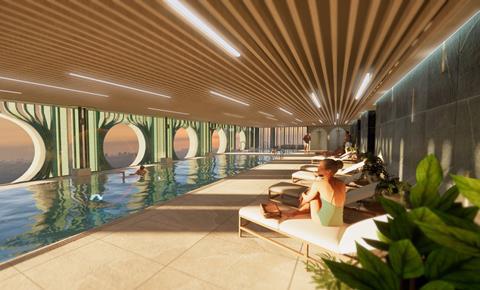
“I think they just wanted to see this period where they could sort of trial it, see what works, and then make a decision based on a bit of empirical evidence,” he adds. Early in the pandemic, there was speculation that the new working paradigm could result in a mass-downsizing. But, as time has gone on, that analysis has become increasingly simplistic.
Firms are beginning to realise that to coax employees back to the office, the office itself has to change. During the pandemic, the homes of many workers became much more like their offices, but now developers realise they must make the office as comfortable as the home.
In many cases this means occupiers need more space rather than less, as they seek an edge in the amenity arms race. As Wharton says, “if you’ve not got a cycle store and a shower block in your basement these days, you’re not in the market” – and indeed many have gone much further. The Alberton, Bruntwood’s planned 18-storey office block by Manchester Canal, is set to feature the highest swimming pool in a UK office building as part of a rooftop holistic wellness centre.
[Developers] are going to see these returns in less tangible ways than just rent – they’re going to see it in occupancy and in happy, vibrant buildings
But developers are now having to go beyond amenity and try to foster a sense of organic community around their office developments, something that has been an emphasis for Bruntwood in Circle Square, MEPC in Noma and Downing in First Street. “Those little districts I think will all try to incorporate that sense of ‘there’s a bit more going on here than just a sterile office district’. It will be a lifestyle place with leisure and retail and amenity and bars and restaurants and that kind of thing,” says Wharton.
Deloitte partner Simon Bedford, who leads the firm’s regional development business from Manchester, agrees. “I think the days of just having sort of an office quarter are gone,” he says. “The days of being part of a particular neighbourhood in the city – that is something that people are more attracted by, with interesting ground-floor uses, with great public realm, preferably without cars.”
In many ways, these new commercial neighbourhoods are doing in the centre of Manchester, what had been done out in Salford Quays at Peel Media’s MediaCityUK. Last month the developer lodged plans for another large office block in the development, designed by Sheppard Robson.
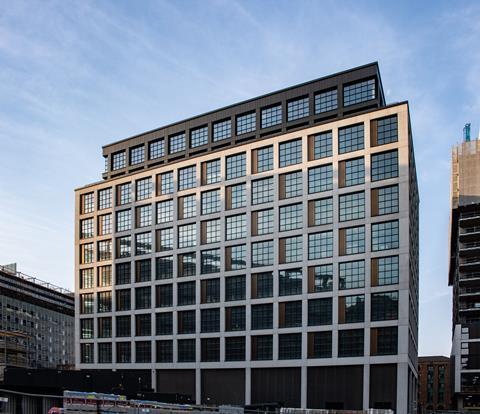

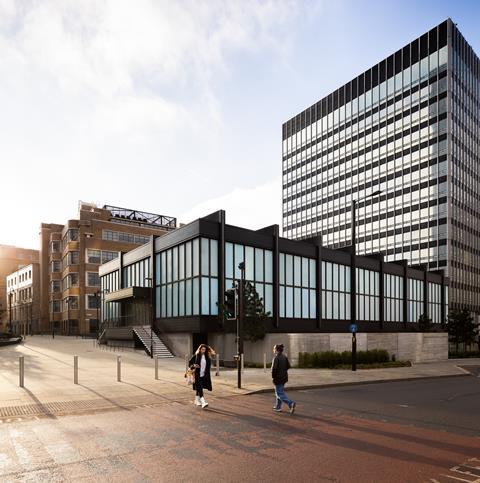
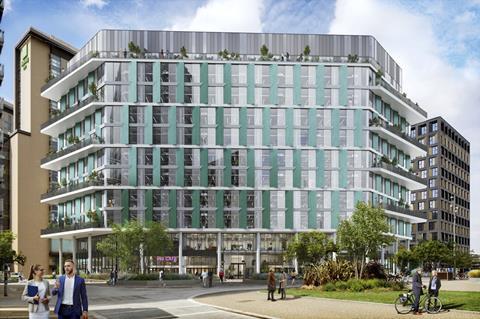
Reacting to these changing occupier demands quickly is going to be crucial for developers looking to make their scheme stand out in a competitive pack. Peter Gallagher, consultant for Colliers, NOMA’s commercial agent, says that this project has been “wholly driven” around the idea of creating a “community of use”.
The client on 4 Angel Square, a 22,000m2 office building in NOMA expected to complete early next year, agreed to take a large part of the ground floor, which could have been an income‑generating commercial space, out of the lettable space to be used for a range of occupier activities. Revised proposals for 2 & 3 Angel Square are currently being considered by Manchester city council.
The scheme had originally been granted planning consent in 2019, but shifting trends forced a rethink, with the building redesigned for better integration with outside space and larger areas of the building repurposed for wellbeing activities.
“Developers like to see a return on their money, and they are going to see these returns in less tangible ways than just rent – they’re going to see it in occupancy and in happy, vibrant buildings,” says Gallagher.
He adds that large, campus-style developments like NOMA have a natural advantage in such placemaking endeavours, as they can curate the space between the buildings in a way that is not possible with individual office blocks.
The buildings that these companies occupy now are very visible signs of where they are in the whole debate on carbon.
One of the major drivers behind this community agenda is the need for corporates to win the battle for talent. A modern, flexible office space in a vibrant and energetic neighbourhood remains a draw for young talent, which has never been in higher demand.
Says Gallagher: “It’s probably an unpopular thing to say, but the employee has the whip-hand at the moment. They can choose where they want to work, and if they don’t like it, they can choose somewhere else quite readily.”
By and large, they are choosing thriving cities like Manchester. Many corporates are drawn to the city because it has the highest student population outside London, more than half of whom remain in the city after graduation – once again, a statistic second only to London.
“Those graduates want to live and work in the city centre,” says Wharton. “They don’t particularly want to live out in the sticks and have to commute or drive out and drive back in – they want to live in Ancoats, work in Spinningfields and go get [drunk] in Castlefield.”
Despite the draw of the bright lights, demand remains strong in historically popular office hubs on the periphery of the city – places such as Wilmslow, Knutsford and Altrincham. Sheppard Robson partner Tony O’Brien, who leads the practice’s office and residential projects from its Manchester office, speculates that banks and legal firms, which have a lot of staff working from home in the commuter belt, may begin to opt for smaller, more flexible spaces closer to these towns.
Greater Manchester’s new-look neighbourhoods
St John’s Enterprise City

In the heart of the city centre and neighbouring Spinningfields, St John’s Enterprise City will be a mixed-use neighbourhood on the former Granada Studios estate, home to a cluster of media and tech businesses. As well as new offices, the project incorporates co-working facilities, a cinema and a Soho House hotel. This spring, Lendlease completed the 82,900ft2 Globe Building, which will be a campus for WPP’s cohort of businesses and others. It is the second office Lendlease has built for the Allied London scheme, having handed over the 320,000ft2 Manchester Goods Yard last year.
NOMA
![2 & 3 Angel Square - Angel Square Public Realm NOMA - View 04 - 2022 Issue06[1] (1)](https://d3sux4fmh2nu8u.cloudfront.net/Pictures/480xany/8/1/2/1930812_23angelsquareangelsquarepublicrealmnomaview042022issue0611_834589.jpg)
A decision on whether to approve revised plans for 2 & 3 Angel Square, the latest developments on the 20-acre NOMA site, is expected this autumn. The two buildings were designed by Cartwright Pickard to connect with the public realm around NOMA, encouraging collaboration and interaction.
“The next generation of employees are more sustainably conscious than ever before and providing them with the most sustainable and user-friendly working environment with access to green space can become the important differentiator,” says Dan Hyde, MEPC’s development director.
The buildings will join the landmark One Angel Square, as well as the SimpsonHaugh-designed 4 Angel Square which is due for completion early next year.
New Bailey
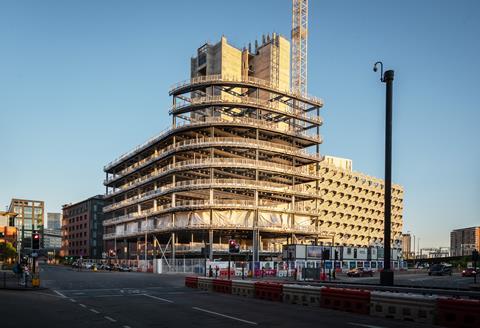
The New Bailey office district is part of a £1bn Salford Central masterplan being delivered by the English Cities Fund – a joint venture between Muse Developments, L&G and Homes England. HM Revenue & Customs recently took residence in the Make Architects-designed 3 New Bailey (left), a seven-storey block featuring a distinctive red-brick weave facade which joined One and Two New Bailey on the site last year.
After completing the building, contractor Bowmer + Kirkland moved on to 4 New Bailey, which was also designed by Make and which has already been pre-let to BT. A fifth building, called Eden (above), is expected to complete next year and will feature Europe’s largest living wall.
The competition among corporates for new recruits is also helping to drive competition among office developers to out-green and out-clean one another. According to Gallagher, recruiters are routinely being grilled by prospective employees about the ESG policies of companies, with major consequences for the built environment.
“The buildings that these companies occupy now are very visible signs of where they are in the whole debate on carbon,” he says. Many companies have made statements to their shareholders committing to net zero, and according to the climate change committee, direct greenhouse gas emissions from buildings accounted for 17% – that’s without taking into account embodied carbon.
“Where you have an office, that is going to be crucial to achieving those commitments that you’ve made to the stock market,” says Wharton.
When the Co-operative Group moved into One Angel Square in NOMA in 2013, it was one of the most sustainable large buildings in the world. Now there are a plethora of planned and completed developments across Manchester – Landmark, No.1 Spinningfields, New Bailey, Circle Square, First Street and the most recent developments at Angel Square – all being developed to BREEAM Excellent standard or better, all jostling to outcompete one another on their green credentials.
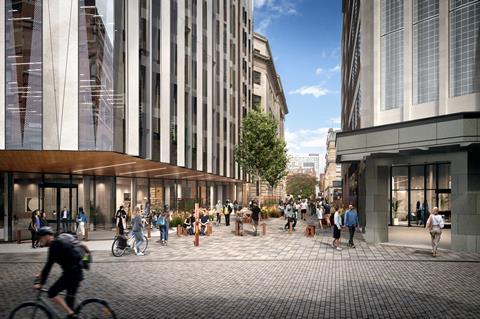
This flight to quality could be good news for the refurbishment and retrofit market, as landlords of older developments seek to avoid being left behind. Deloitte’s Bedford says: “Manchester’s always had a very strong refurbishment market in the office sector.” He adds that much of the work in recent years – such as Bruntwood Works’ Bloc development, which features a living wall and wildflower roof – has been focused on improving sustainability.
There do, of course, remain headwinds, with rampant inflation impacting building costs and fears of a recession on the other side of the new year. But, in Manchester’s office market, at least, there is confidence in the sector’s ability to weather these challenges.
“2023 particularly could be a very difficult year to navigate in that context,” says Bedford. “But, over a longer period, we have to assume that inflation will not be a feature of our economy, in the way in which it was 30 years ago. In that context, I think I think we would expect to return to what has been a very strong period for a regional city like Manchester.”
Building’s Manchester week

It’s holiday season and Building is taking a staycation in Manchester: this week we zoom in on the north of England’s biggest and most vibrant city, talking to those shaping its skyline, creating workspaces, building homes, designing space for leisure and fun.
On Friday we published an exclusive interview with Andy Burnham, mayor of Greater Manchester.
Further online features this week include:
- Monday 15 August: Tony Wilson’s legacy in Manchester: ‘A city where you can stay up north and be successful’
- Tuesday 16 August: A run-down of some of the movers and shakers in Mancunian development
- Wednesday 17 August: Mayfield Park is Manchester’s first new public park in a century
- Thursday 18 August: Manchester’s offices market has a host of new schemes in the pipeline
- Friday 19 August: Jodrell Bank has a new £20.5m visitor centre
You can also find all our Manchester articles in August’s print and digital edition out now
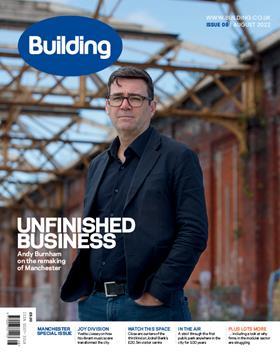
Andy Burnham interview: remaking Manchester

Manchester’s mayor on how green spaces, better infrastructure and the pursuit of net zero are at the heart of his ambitious plans for the city
- 1
- 2
- 3
- 4
 Currently
reading
Currently
reading
How post-pandemic working is driving Manchester’s office neighbourhoods
- 6
- 7








































No comments yet